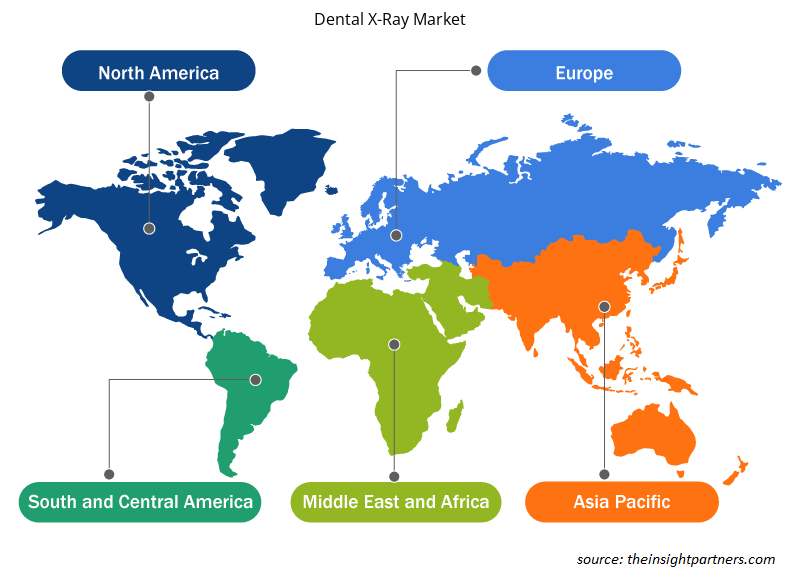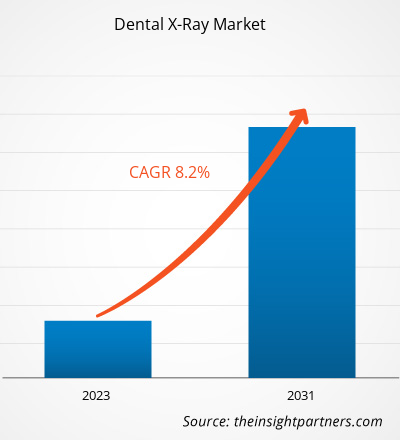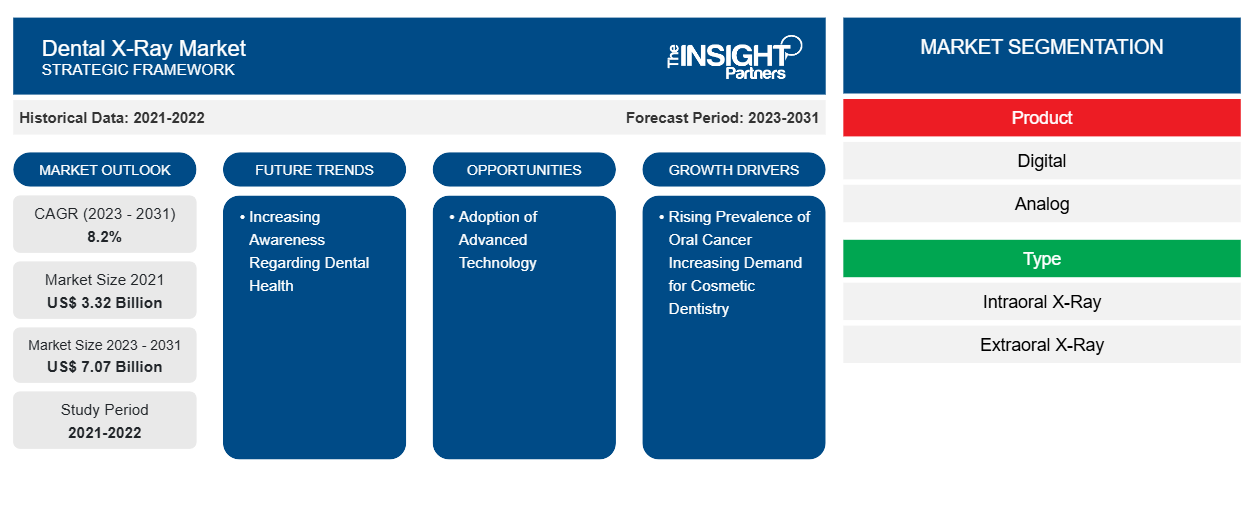El tamaño del mercado de rayos X dentales en 2021 se situó en 3.320 millones de dólares y se prevé que alcance los 7.070 millones de dólares en 2031, frente a los XX mil millones de dólares en 2023. Se espera que el mercado registre una CAGR del 8,2% entre 2023 y 2031. Es probable que la adopción de tecnología avanzada, como el uso del sistema de tomografía computarizada de haz cónico (CBCT), siga siendo una de las tendencias clave del mercado de rayos X dentales.
Análisis del mercado de radiología dental
Los controles dentales periódicos, junto con el uso adecuado de rayos X, ayudan a mantener una excelente salud bucal y a prevenir el avance de las enfermedades dentales. La mayor aceptación de la odontología estética, el aumento de los problemas dentales y el aumento de la población de edad avanzada son los principales factores que impulsan el mercado de las radiografías dentales.
Descripción general del mercado de rayos X dentales
En la odontología moderna, hoy en día se requieren dispositivos de diagnóstico para proporcionar una atención precisa e integral al paciente. Entre estas herramientas, las radiografías dentales se destacan como un componente esencial en el diagnóstico. Las radiografías dentales se han desarrollado como una herramienta de diagnóstico vital en la odontología moderna, mejorando considerablemente la calidad general de la atención al paciente. Desde la detección temprana de trastornos dentales hasta la planificación precisa del tratamiento, las ventajas de las radiografías son innegables.
Personalice este informe según sus necesidades
Obtendrá personalización en cualquier informe, sin cargo, incluidas partes de este informe o análisis a nivel de país, paquete de datos de Excel, así como también grandes ofertas y descuentos para empresas emergentes y universidades.
-
Obtenga las principales tendencias clave del mercado de este informe.Esta muestra GRATUITA incluirá análisis de datos, desde tendencias del mercado hasta estimaciones y pronósticos.
Factores impulsores y oportunidades del mercado de radiología dental
La creciente prevalencia del cáncer bucal favorece el crecimiento del mercado
La incidencia de afecciones dentales y bucales está aumentando en todo el mundo, como endodoncias, pérdida de dientes, boca seca, caries, cáncer bucal y otras. La pérdida de dientes, las caries y las endodoncias son los principales problemas dentales a los que se enfrentan las personas en todo el mundo. El cáncer bucal ocupa el sexto lugar entre los cánceres más comunes en el Reino Unido; cada año se notifican unos 4.900 casos nuevos en el país. Se utilizan radiografías para evaluar si el cáncer ha progresado a órganos distintos de la boca y la orofaringe.
Aumentar la conciencia sobre la salud dental
El Día Mundial de la Salud Bucodental fue establecido por la Federación Dental Internacional (FDI) y es la mayor campaña mundial de concienciación sobre la salud bucodental. La campaña anual difunde la conciencia sobre las prácticas de higiene bucodental para niños y adultos y explica la importancia de la salud bucodental para mantener la salud y el bienestar general. Por ejemplo, la FDI liderará con ''UNA BOCA FELIZ, ES UN CUERPO FELIZ'' en 2024, alentando al público a comprender los beneficios de una boca sana y feliz arrojando luz sobre el complejo vínculo entre la salud general y la salud bucodental. El objetivo de la campaña es motivar a las personas para que cuiden su boca y comprendan que, al hacerlo, también pueden ayudar a proteger su bienestar general. La campaña tiene como objetivo difundir la conciencia sobre la salud bucodental, ya que es una oportunidad para realizar radiografías dentales.
Análisis de segmentación del informe de mercado de rayos X dentales
Los segmentos clave que contribuyeron a la derivación del análisis del mercado de rayos X dentales son el producto, el tipo y la aplicación.
- Según el producto, el mercado de radiografías dentales se divide en digital y analógico. El segmento digital tuvo una mayor participación de mercado en 2023.
- En términos de tipo, el mercado se bifurca en radiografía intraoral y radiografía extraoral. La aleta de mordida, la periapical y la oclusal son subsegmentos destacados dentro del segmento de radiografía intraoral. Además, CBCT, panorámica y otros son subsegmentos elaborados bajo el segmento de radiografía extraoral. El segmento de radiografía intraoral dominó el mercado en 2023.
- Por aplicación, el mercado se segmenta en medicina, cosmética y forense. El segmento médico tuvo la mayor participación del mercado en 2023.
Análisis de la cuota de mercado de los rayos X dentales por geografía
El alcance geográfico del informe del mercado de rayos X dentales se divide principalmente en cinco regiones: América del Norte, Asia Pacífico, Europa, Medio Oriente y África, y América del Sur y Central.
América del Norte ha dominado el mercado de radiografías dentales. El crecimiento del mercado en América del Norte se debe a diversos factores, como la creciente concienciación sobre las imágenes dentales, la inversión gubernamental en infraestructura sanitaria y los beneficios asociados a la detección temprana y el tratamiento de enfermedades dentales. Además, es probable que la presencia de líderes del mercado en la región también fomente el crecimiento de la región en los próximos años.
Perspectivas regionales del mercado de rayos X dentales
Los analistas de Insight Partners explicaron en detalle las tendencias y los factores regionales que influyen en el mercado de rayos X dentales durante el período de pronóstico. Esta sección también analiza los segmentos y la geografía del mercado de rayos X dentales en América del Norte, Europa, Asia Pacífico, Oriente Medio y África, y América del Sur y Central.

- Obtenga datos regionales específicos para el mercado de rayos X dentales
Alcance del informe de mercado de rayos X dentales
| Atributo del informe | Detalles |
|---|---|
| Tamaño del mercado en 2021 | US$ 3.32 mil millones |
| Tamaño del mercado en 2031 | US$ 7.07 mil millones |
| CAGR global (2023 - 2031) | 8,2% |
| Datos históricos | 2021-2022 |
| Período de pronóstico | 2023-2031 |
| Segmentos cubiertos |
Por producto
|
| Regiones y países cubiertos |
América del norte
|
| Líderes del mercado y perfiles de empresas clave |
|
Densidad de actores del mercado de rayos X dentales: comprensión de su impacto en la dinámica empresarial
El mercado de radiografías dentales está creciendo rápidamente, impulsado por la creciente demanda de los usuarios finales debido a factores como la evolución de las preferencias de los consumidores, los avances tecnológicos y una mayor conciencia de los beneficios del producto. A medida que aumenta la demanda, las empresas amplían sus ofertas, innovan para satisfacer las necesidades de los consumidores y aprovechan las tendencias emergentes, lo que impulsa aún más el crecimiento del mercado.
La densidad de actores del mercado se refiere a la distribución de las empresas o firmas que operan dentro de un mercado o industria en particular. Indica cuántos competidores (actores del mercado) están presentes en un espacio de mercado determinado en relación con su tamaño o valor total de mercado.
Las principales empresas que operan en el mercado de rayos X dentales son:
- Dentsply Sirona,
- Corporación Envista Holdings,
- Planmeca Oy,
- Cuidado de la salud de Carestream Inc.,
- Técnicas de aire Inc.,
- Imágenes Apteryx Inc.,
Descargo de responsabilidad : Las empresas enumeradas anteriormente no están clasificadas en ningún orden particular.

- Obtenga una descripción general de los principales actores clave del mercado de rayos X dentales
Noticias y desarrollos recientes del mercado de rayos X dentales
El mercado de radiografías dentales se evalúa mediante la recopilación de datos cualitativos y cuantitativos a partir de investigaciones primarias y secundarias, que incluyen publicaciones corporativas importantes, datos de asociaciones y bases de datos. A continuación, se incluye una lista de los avances en el mercado de radiografías dentales:
- Overjet, líder en soluciones de inteligencia artificial para odontología para DSO y compañías de seguros, anunció que obtuvo una patente en los Estados Unidos (patente estadounidense n.° 11158046B2) por su invención de una tecnología de inteligencia artificial innovadora para medir con precisión las estructuras anatómicas y cuantificar enfermedades en radiografías dentales. (Fuente: Overjet, comunicado de prensa, 2022)
- LunaLite Dental, una empresa líder en tecnología dental, se enorgullece de presentar la última innovación en el cuidado dental: el posicionador automático de rayos X dentales guiado por láser LunaLite. Este dispositivo de vanguardia está destinado a revolucionar la forma en que se toman las radiografías dentales, brindando una experiencia más eficiente y cómoda tanto para los profesionales dentales como para los pacientes. (Fuente: LunaLite Dental, comunicado de prensa, 2023)
Informe sobre el mercado de rayos X dentales: cobertura y resultados
El informe “Tamaño y pronóstico del mercado de rayos X dentales (2021-2031)” proporciona un análisis detallado del mercado que cubre las siguientes áreas:
- Tamaño del mercado y pronóstico a nivel global, regional y nacional para todos los segmentos clave del mercado cubiertos bajo el alcance
- Dinámica del mercado, como impulsores, restricciones y oportunidades clave
- Principales tendencias futuras
- Análisis detallado de las cinco fuerzas de Porter y PEST y FODA
- Análisis del mercado global y regional que cubre las tendencias clave del mercado, los principales actores, las regulaciones y los desarrollos recientes del mercado.
- Análisis del panorama de la industria y de la competencia que abarca la concentración del mercado, el análisis de mapas de calor, los actores destacados y los desarrollos recientes
- Perfiles detallados de empresas
- Análisis histórico (2 años), año base, pronóstico (7 años) con CAGR
- Análisis PEST y FODA
- Tamaño del mercado, valor/volumen: global, regional y nacional
- Industria y panorama competitivo
- Conjunto de datos de Excel
Informes recientes
Informes relacionados
Testimonios
Razón para comprar
- Toma de decisiones informada
- Comprensión de la dinámica del mercado
- Análisis competitivo
- Información sobre clientes
- Pronósticos del mercado
- Mitigación de riesgos
- Planificación estratégica
- Justificación de la inversión
- Identificación de mercados emergentes
- Mejora de las estrategias de marketing
- Impulso de la eficiencia operativa
- Alineación con las tendencias regulatorias























 Obtenga una muestra gratuita para - Mercado de radiografías dentales
Obtenga una muestra gratuita para - Mercado de radiografías dentales